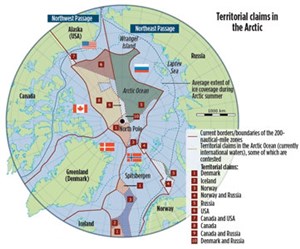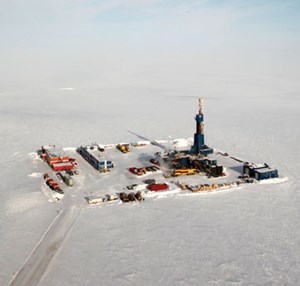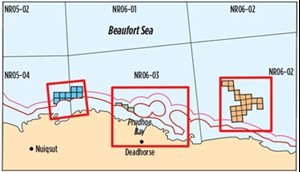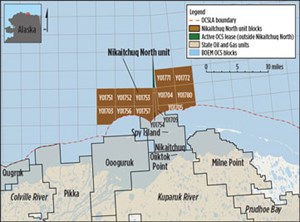Far North runs hot and cold between discoveries and politics
Inside the Arctic Circle, oil and gas prospects rise and fall on international politics and global warming, as much as geology and the price of oil. The countries strung along the circle share a massive resource and a costly, politically contentious theater of operations. Each must contend with issues far removed from the objective of profitably producing oil and gas, in some of the harshest conditions on the planet.
CIRCLING THE POLE
There are eight Arctic countries. Six share a common shoreline around the Arctic Ocean. Five of these are oil and gas producers—Russia, Denmark, Norway, Canada and the United States—and the sixth, Iceland, has aspirations. Only Sweden and Finland have neither oil nor Arctic Ocean beachfront.

Looking north, each of the six faces each other across the frozen expanse. Their boundaries encompass land, territorial seas, and continental shelves, where exclusive economic zones (EEZ) reach 200 nautical miles (370 km) offshore, Fig. 1. But in the middle of the Arctic Ocean, where the EEZs end, there is a ragged doughnut hole of contention. Each of the nations has interests, some of them overlapping, but so far only Norway and Iceland have had extended claims approved by the UN.
The economic incentive behind the six nations’ interest is huge. Sedimentary basins and continental shelves in the Arctic may contain as much as 90 Bbbl of oil and 1,660 Tcf (47 Tcm) of gas, according to the USGS. There may be another $1 trillion in gold zinc, nickel and platinum deposits.
While most of the development has been on land, Arctic sea ice shrinkage is offering new access and opportunities offshore, as well as onshore. The ice sheet typically reaches its minimum extent in September. A standard threshold of where the ice coverage ends is 15% ice concentration over the areal extent. Satellite observations by NASA show September 2017 ice covered approximately 4.8 million mi2, compared to 1980 coverage of 7.9 million mi2, a 13.2%/decade decline rate. The lowest extent in the satellite record is 3.4 million mi2 in 2012.
RUSSIA
Russia has the largest share of Arctic hydrocarbons, with potential reserves of approximately 48 Bbbl of oil and 1,518 Tcf (43 Tcm) of gas, equal to about 55% of Russian proved oil reserves and 85% of proved gas reserves. But that potential is much constrained. According to Chatham House, an independent policy institute based in London, company turf wars and Western sanctions are preventing Russia from effectively extracting oil and gas in the Arctic. They point to U.S. sanctions, the technological shortcomings of state-owned companies Gazprom and Rosneft, and those firms’ unwillingness to cooperate with private Russian companies with relevant experience.
By 2020, those sanctions will result in production declines of 10% in the ensuing decade, said Tatiana Mitrova, a Russian economist and fellow at Columbia University’s Center on Global Energy Policy. In a speech to the Atlantic Council, she explained that Russia needs to develop Arctic hydrocarbon resources, but the country is cut off from specialized expertise. Quoted in the Houston Chronicle, she observed, “There is no expertise in Russia. Rosneft tried to do it in-house. They’re realizing you cannot replace the global oil service industry.”
However, Gazprom Neft, one of Russia’s largest oil producers, says its economic and production outlook for Arctic operations is good. Most Arctic projects could easily turn a profit at current oil prices of $75/bbl, said Andrey Patrushev, deputy CEO for offshore projects, in a Platts interview. To improve long-term gas production, Gazprom Neft in September said its geological exploration would include the Yamal Peninsula and Arctic offshore.
The Yamal LNG project is expected to start exporting LNG from its third 5.5-million mt/year train by the end of 2018, said operator Novatek. Production from the first train began in December 2017, and the second started in August 2018.
The Prirazlomnoye project in the Perchora Sea is Russia’s only offshore Arctic platform. The operator expects oil production this year to increase 33%, to approximately 3.5 million tons (69,710 bpd), and to 5 million tons/year (99,590 bpd) by 2021-2022. Potential exploration in 2024-2026 could increase total production by about 1.1 million tons (21,910 bpd). There are 32 wells planned by 2023: 19 production wells, 12 injectors, and one absorption well. Twelve wells had been drilled by 2017. All the drilling is from the field’s fixed gravity platform—the only stationary production platform in the Arctic. Oil is transferred to an FSO vessel by ice-breaking shuttle tankers, and then to supertankers designed for year-round transit to Europe.
Also in the Pechora Sea, Gazprom Neft expects to complete a review of a 3D seismic survey of Dolginskoye field and the Severo-Zapadny Block by the end of this year.
UNITED STATES
North Slope oil production in Alaska has a much brighter future, if new discoveries and opportunities pan out. The trend has been down. Recent small increases in production from Prudhoe Bay and Alpine field are attributed to technology, cost-cutting and tax credits. Production in 2017 increased about 1.7%, following a 3% uptick in 2016.
Overall production has been declining since 1988, when average annual output peaked at 2.0 MMbopd. Annual production in mid-2017 had fallen to less than 500,000 bopd.
Hope for the future lies in recent discoveries and vast potential of untapped reserves, and the large areas of the state that remain unexplored. Only 533 exploratory wells have been drilled on the North Slope, according to the Alaska Department of Natural Resources (ADNR).
The western Beaufort Sea and adjacent state and native lands, and State waters, may have much more potential than previously thought. Undiscovered and technically recoverable reserves amount to 17.6 Bbbl of oil and more than 50 Tcf of gas, said the U.S. Department of the Interior (DOI) in its resource assessment for the National Petroleum Reserve (NPR-A).
That’s a significant increase in land and offshore resources. Onshore, the estimated 8.7 Bbbl of oil and 25 Tcf of gas compare to a 2010 resource assessment of 1.5 Bbbl of oil. Offshore, the revised estimates are 8.9 Bbbl of oil and 27.7 Tcf of gas, a net increase of nearly 700 MMboe.
Brookian sequences. Recent activity and pending production from Brookian sequences in the Nanushuk and Torok formations are very positive. A six-fold increase in recoverable reserves in Brookian sequence stratigraphic traps in the cretaceous sandstone formations may total 5 Bbbl of oil. The gain is key to an IHS Markit estimation that North Slope oil production may increase as much as 40% by 2026.
The Brookian plays have, to date, been largely unexplored for many reasons. In a May 2018 report to the AAPG, Paul Decker with the ADNR explained that the sequence of clastic rock is “variable and confusing,” and lacking in context; the Nanushuk and Torok are not found in the developed fields to the east; adjacent horizontal drilling to reach deeper objectives left upper units unexplored; and there are doubts about the existence of large topset stratigraphic traps.

Major recent Brookian discoveries include Caelus Energy’s two Smith Bay wells drilled to the Toruk in state waters off the National Petroleum Reserve-Alaska (NPR-A). Expected production is under 200,000 bopd. ConocoPhillips’ Willow discovery taps the Nanushuk in federal waters off the NPR-A. Seven holes have been drilled and expected production is 40,000 to 100,000 bopd. Oil Search’s and ConocoPhillips’ Pikka/Horseshoe onshore discoveries in the Colville Delta have drilled 12 wellbores to explore the Nanushuk, and expected production is under 120,000 bopd.
Repsol and partner Armstrong Energy’s Horseshoe and Pikka oil discoveries in the Nanushuk play are reported to be the largest U.S. onshore oil discovery in 30 years, with more than 1 Bbbl of recoverable oil, Fig. 2. The Horseshoe well in 2017 extends the 2015 Pika discovery by 20 mi, and the wells may tap a single asset. The discoveries are near the Colville River delta, just outside NPR-A.
High hopes for a big find by Caelus Energy at Smith Bay have reportedly been frustrated by the state’s oil tax system, resulting in the delay of a third appraisal well. In 2016, the company announced an estimated potential of 6 Bbbl of oil, based on seismic data and the results of two exploratory wells reaching tight Brookian sandstones in the Tulimaniq area near the mouth of the Ikpikuk River. Caelus Energy said horizontal drilling and hydraulic fracturing would be needed to effectively develop the resource.
Beaufort Sea. Leases in the Beaufort Sea OCS are held by a handful of companies, according to the U.S. Bureau of Offshore Energy Management (BOEM). They are: ASRC Exploration, 100% of 21 leases; Eni, 50% and Shell offshore, 50%, of 13 leases; Hilcorp, 100% of three leases; and Hilcorp, 50%, BPX 40%, and ASCR, 10%, of three leases.
Eni spudded its Nikaitchuq North No. 1, in December 2017, and expected to reach TD and test the well in August 2018, Fig. 3. A second well is planned for the end of the year. The two Harrison Bay wells are being drilled from an existing artificial gravel island in state waters, and will extend approximately 6 mi under shallow federal waters. Eni has interests in 42 Alaskan exploration and development blocks, primarily in Nikaitchuq and Oooguruk fields, with a 2017 overall net production of approximately 20,000 bopd.
ASRC Exploration’s Taktuk unit contains two historical exploration wells, Hammerhead 1 and 2, which were drilled in 1985 and 1986, respectively, according to the U.S. Bureau of Safety and Environmental Enforcement (BSEE). Union Oil Company drilled the two exploratory wells. ASRC acquired 21 leases from Shell in November 2016. They were subsequently unitized into the newly formed Taktuk unit. ASRC Exploration is part of the Arctic Slope Regional Corporation, a Native Alaskan firm representing the business interests of the Inupiaq.
The Liberty Project partnership between Hilcorp, ASRC and BP is 5.5 mi offshore, in about 20 ft of water, inside the Beaufort Sea’s barrier islands. It is 20 mi east of Prudhoe Bay and about 8 mi east of the existing BP-operated Endicott oil field. The unit was acquired in 2014. A development and production plan was filed that year. In July 2018, the final environmental impact statement for the project was published.

Hilcorp estimates that the Liberty unit has 80 MMbbl to 150 MMbbl of oil. The company projects peak production of between 60,000 and 70,000 bopd within two years of initial output. It plans to build a nine-acre artificial gravel island in the shallow waters. Sited about 5 mi off the coast, the facility would be similar to the four oil- and gas-producing artificial islands operating in the area’s state waters: Spy Island, Northstar Island, Endicott Island and Oooguruk Island. A subsea pipeline will deliver oil to the Trans-Alaska Pipeline System.
ANWR. In 2017, the U.S. federal government ended the prohibition against drilling in the Arctic National Wildlife Refuge (ANWR) by opening a small portion—the 1002 Area—of the refuge along Alaska’s northern coast to energy development, Fig. 4.
The new tax act requires a competitive oil and natural gas program for the leasing, development, production and transportation of oil and natural gas from the area’s coastal plain. In compliance, two lease sales have been ordered—one within four years and the second within seven years.
In this scenario, the first production from ANWR could occur in 2031, 10 years after the first lease sale. The EIA timeline allows for exploration, appraisal, permitting and development and, notably, assumes no protracted legal battle in approving the BLM’s draft Environmental Impact Statement, collection of seismic data, or the approval of a specific lease-development proposal.
The coastal plain covers 1.5 million acres and is about 8% of the total area of ANWR.
Its potential is uncertain, because only one well has been drilled, and the results of the 1986 test have remained confidential and subject to a great deal of speculation. The KIC-1well was drilled in the far eastern end of the area by BP, Chevron and two Alaska Native corporations.
The most recent ANWR resource assessment is a 1998 USGS study that estimates total technically recoverable crude oil from the coastal plain may be more than 5.7 Bbbl. That’s based mostly on production from neighboring state lands and 2D seismic data collected by a petroleum industry consortium in 1984 and 1985.
CANADA
In 2016, Canada joined the U.S. in banning offshore activity in the Arctic. The U.S. reversed its executive decision in 2017, while Canada has not. As a result, Canadian Arctic development has been brought to a standstill.
In December 2017, the Mackenzie Gas Project (MGP) was formally dissolved. The MGP partnership included Imperial Oil, the lead partner, Aboriginal Pipeline Group, ConocoPhillips, Shell Canada and ExxonMobil Canada. Most of the partners had already scaled back or sold off assets in the Canadian Arctic.
Imperial said that since the project began in 2000, the gas market has changed significantly, making Mackenzie gas uncompetitive with other gas resources. The C$16.2-billion proposal (from C$5 billion in 2001) included a pipeline to carry gas from the Beaufort Sea to northern Alberta, a gathering system and a gas processing plant.
NORWAY AND DENMARK
New calculations by the Norwegian Petroleum Directorate suggest that undiscovered oil and gas resources in the Barents Sea are twice as large as previously assumed. Undiscovered resources on the Norwegian Continental Shelf will likely play an important role in maintaining profitable petroleum activities, said the directorate.
Equinor (formerly Statoil) struck oil in Johan Castberg field, offshore Norway in the southern Barents Sea back in 2011. Reserves were estimated at 450 MMboe to 650 MMboe. Poor oil prices in 2015 delayed the development decision, but in December 2017, a production and development plan was submitted, which includes a production vessel and 30 subsea wells, 10 subsea templates and two satellite structures.In the interim, Statoil said that it halved capital expenditures for the project, to make the venture profitable at oil prices of less than $35/bbl. First oil is expected in 2022, with production continuing for three decades or more.
In 2017, Statoil and partners had non-commercial gas from the Korpfjell well in the southeast Barents Sea. Korpfjell is the first exploration well drilled in the Norwegian section of a formerly disputed area between Norway and Russia. The drilling focused on oil, but it produced only small gas volumes. The gas discovery is estimated to contain non-commercial reserves of 40 MMbbl to 75 MMbbl of recoverable oil equivalents and 6 Bcm to 12 Bcm of gas.
ICELAND
In the end, politics and melting ice aside, Iceland’s recent experience reinforces the fact that geology ultimately rules all. Iceland’s only licenses to explore the Dreki Area on its northwest continental shelf were returned following 2D seismic work. In 2017, Ithaca Energy relinquished its license, and CNOOC and Eykon Energy gave up theirs in early 2018.
GROWING ARCTIC ACTIVITY
Around the circle, Arctic nations are keenly focused on regional resources from many perspectives. While politics and the environment play a strong role in oil and gas development, greater access, potential reserves, and impressive new discoveries point to a growing energy presence in the Arctic’s future. ![]()
- Applying ultra-deep LWD resistivity technology successfully in a SAGD operation (May 2019)
- Adoption of wireless intelligent completions advances (May 2019)
- Majors double down as takeaway crunch eases (April 2019)
- What’s new in well logging and formation evaluation (April 2019)
- Qualification of a 20,000-psi subsea BOP: A collaborative approach (February 2019)
- ConocoPhillips’ Greg Leveille sees rapid trajectory of technical advancement continuing (February 2019)



